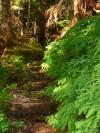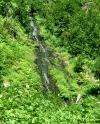


Washington State...July 2002
Just click on the pictures to enlarge photo's.
 |
 |
 |
 |
 |
 |
 |
| Big Tree | Chicago Camp | Third night | Elwha River | Layers of Ferns | Waterfall | Solid rock trail |
Superlatives about the trees abound, for several specimens reach record sizes. In some locations, the forest canopy is so thick that falling snow is caught in the trees and never reaches the ground.
There are four basic types of forests on the Olympic peninsula: Temperate rain forest, lowland, montane, and subalpine. Temperate rain forest is found at low elevations along the Pacific Ocean coast and in the western-facing valleys of the peninsula where lots of rain, moderate temperatures, and summer fogs exist. Sitka spruce is the dominant tree, but trees typical of the lowland forest also grow here, including western redcedar.
The lowland forest grows further inland from the coast, and above the rain forest valleys. You will not find Sitka spruce here, but you may see grand fir. Western hemlock will probably be the most common tree, although stands of Douglas-fir may prevail where fire or drier conditions caused by the rain shadow give these trees an advantage. Western redcedar is never an abundant tree, but its gradual disappearance is a true indicator that the upper limits of this zone have been reached.
Gradually the lowland forest gives way to the montane forest. Unless you are an expert you may have difficulty recognizing when the change occurs. If silver fir is present you know that you have moved into the montane zone, but in drier parts of the park, the montane zone may look much like the lowland forest, with the exception that the western red cedar will no longer be present.
As elevation increases, temperatures cool and more moisture falls as snow; growing seasons get shorter and the subalpine zone takes over. Silver fir grows here as well as in the montane zone, and in the western portion of the park may be prevalent. The presence of subalpine fir, mountain hemlock, or Alaska cedar groves assure you that this is the subalpine zone. The lower portion of the subalpine zone consists of continuous forest, but in the upper part of this zone the forest thins out. Delightful alpine meadows graced with wildflowers and glacial lakes often intermingle with stands of firs. Subalpine fir is especially well adapted to the heavy snows and cold temperatures experienced here. Its spire-like shape sheds snow. It also extends its lower branches under the snow, often putting down roots from them where they touch the ground. When the snow melts the trees may be surrounded by skirt-like arrangements of longer, lower branches.
Increasing elevation causes even more severe climatic conditions. Trees become fewer, shorter, and more misshapen. Trees may be mere shadows of their cousins living lower down the mountain. Here a 100-year-old tree may be only three feet tall. Eventually tree line is reached, beyond which trees do not grow, but a profusion of wildflowers often rewards your eye in a vivid display that is an effective foil to the scenery below, now visible because the trees no longer block the view.